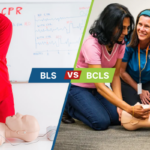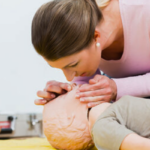
- Last Updated On: July 15, 2024
What Does CPR Stand For And Why Is It Important
Table Of Contents
- What does CPR stand for and what are its key components?
- Why is CPR important?
- Conclusion
CPR stands for Cardiopulmonary Resuscitation and it includes life saving techniques used in emergencies. CPR is performed when someone’s heartbeat or breathing has stopped. Several underlying health issues can lead to this critical condition. When CPR is administered, blood circulation to the vital organs is restored. The success rate of CPR is estimated to be over 75% in all situations, be it drowning, choking or SCA (Sudden Cardiac Arrest). When an individual is trained in CPR, their confidence and competence is tested. This verifies if the person is capable of responding quickly and effectively in emergency situations.
This blog will serve as a complete guide to understanding the dynamics of CPR along with recognizing what CPR stands for.
What does CPR stand for and what are its key components?
CPR includes its two primary components, chest compressions and rescue breaths. While chest compressions involve pressing down firmly on the chest in a rhythmic manner, the goal is to help the heart circulate blood. Rescue breaths on the other hand are mouth to mouth (adults) or mouth to nose (children) breaths that provide oxygen to the patient’s lungs. Apart from the chest compressions and rescue breaths, a series of steps needs to be followed to ensure the quality of CPR administered. Let’s go through the steps one by one-
- Early Recognition and Activation: Recognizing the signs of cardiac arrest or respiratory distress and activating emergency medical services (EMS) promptly is crucial. Quick action can significantly improve the chances of survival.
- Checking for Responsiveness: Before starting CPR, it’s essential to check if the person is responsive by tapping and shouting. If there is no response, it indicates the need for immediate CPR.
- Assessment of Breathing: After establishing unresponsiveness, check for normal breathing or signs of breathing difficulties. If the person is not breathing normally or gasping, CPR should be initiated.
- Proper Hand Placement for Chest Compressions: Chest compressions should be performed in the center of the chest, between the nipples, with the hands interlocked. Maintaining the correct hand placement ensures effective compression of the heart.
- Compression Depth and Rate: The depth and rate of chest compressions are crucial. Compressions should be at least 2 inches deep for adults and performed at a rate of 100 to 120 compressions per minute.
- Minimizing Interruptions: Continuous chest compressions with minimal interruptions are vital for maintaining blood flow. Interruptions should be kept as brief as possible, especially during the transition between compressions and rescue breaths.
- AED Use (Automated External Defibrillator): If available, an AED should be used alongside CPR. These devices deliver a controlled electric shock to restore the heart’s normal rhythm in cases of certain cardiac arrhythmias, increasing the chance of survival.
- Monitoring and Adjusting Technique: Throughout CPR, it’s essential to monitor the person’s response and adjust the technique as needed. This may include reassessing breathing, ensuring proper hand placement, and maintaining the appropriate compression depth and rate.Also read,stay calm while performing CPR.
Why is CPR important?
Standing as a fundamental lifesaving technique, CPR is crucial in cases of cardiac arrest and respiratory failure. It bridges the gap between life and death in unpredictable and critical moments. Apart from encouraging preparedness in a community, learning CPR comes with a lot of benefits. Let’s find out why cardiopulmonary resuscitation is important.
- Immediate Response: CPR provides immediate aid, increasing the chances of survival until professional medical help arrives.
- Sudden Cardiac Arrest: CPR is crucial in cases of sudden cardiac arrest, where prompt intervention is essential for survival.
- Preserving Brain Function: By maintaining blood circulation, CPR helps prevent brain damage due to oxygen deprivation.
- Universal Accessibility: Basic CPR training is accessible to individuals of all backgrounds, empowering anyone to intervene in emergencies.
- Increasing Survival Rates: CPR significantly increases survival rates for victims of cardiac arrest.
- Community Resilience: CPR-trained individuals contribute to community resilience, creating safer environments and saving lives.
- Reducing Disability: Timely CPR reduces the risk of long-term disability in survivors of cardiac arrest.
- Empowering Bystanders: CPR training empowers bystanders to take action and make a difference in emergency situations.
- Cost-Effective: CPR is a cost-effective intervention that can be performed with minimal equipment, saving healthcare resources.
- Legal and Ethical Duty: In many jurisdictions, there’s a legal and ethical duty to provide CPR assistance when witnessing a medical emergency.
Conclusion
CPR stands for cardiopulmonary resuscitation and it is a critical link in the chain of survival. With the help of a CPR online training course, individuals can preserve brain function and sustain vital circulation. As a universal and accessible technique, everyone should actively participate to stay prepared for emergencies. Your action will eventually make an impact, strong enough to save lives and encourage safer and prepared societies.
Read More: Do you want to get CPR recertified?






